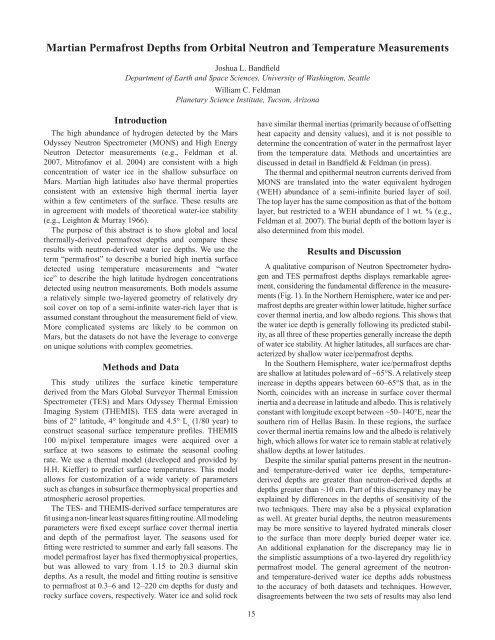Ninth International Conference on Permafrost ... - IARC Research
Ninth International Conference on Permafrost ... - IARC Research
Ninth International Conference on Permafrost ... - IARC Research
Create successful ePaper yourself
Turn your PDF publications into a flip-book with our unique Google optimized e-Paper software.
Martian <strong>Permafrost</strong> Depths from Orbital Neutr<strong>on</strong> and Temperature MeasurementsJoshua L. BandfieldDepartment of Earth and Space Sciences, University of Washingt<strong>on</strong>, SeattleWilliam C. FeldmanPlanetary Science Institute, Tucs<strong>on</strong>, Ariz<strong>on</strong>aIntroducti<strong>on</strong>The high abundance of hydrogen detected by the MarsOdyssey Neutr<strong>on</strong> Spectrometer (MONS) and High EnergyNeutr<strong>on</strong> Detector measurements (e.g., Feldman et al.2007, Mitrofanov et al. 2004) are c<strong>on</strong>sistent with a highc<strong>on</strong>centrati<strong>on</strong> of water ice in the shallow subsurface <strong>on</strong>Mars. Martian high latitudes also have thermal propertiesc<strong>on</strong>sistent with an extensive high thermal inertia layerwithin a few centimeters of the surface. These results arein agreement with models of theoretical water-ice stability(e.g., Leight<strong>on</strong> & Murray 1966).The purpose of this abstract is to show global and localthermally-derived permafrost depths and compare theseresults with neutr<strong>on</strong>-derived water ice depths. We use theterm “permafrost” to describe a buried high inertia surfacedetected using temperature measurements and “waterice” to describe the high latitude hydrogen c<strong>on</strong>centrati<strong>on</strong>sdetected using neutr<strong>on</strong> measurements. Both models assumea relatively simple two-layered geometry of relatively drysoil cover <strong>on</strong> top of a semi-infinite water-rich layer that isassumed c<strong>on</strong>stant throughout the measurement field of view.More complicated systems are likely to be comm<strong>on</strong> <strong>on</strong>Mars, but the datasets do not have the leverage to c<strong>on</strong>verge<strong>on</strong> unique soluti<strong>on</strong>s with complex geometries.Methods and DataThis study utilizes the surface kinetic temperaturederived from the Mars Global Surveyor Thermal Emissi<strong>on</strong>Spectrometer (TES) and Mars Odyssey Thermal Emissi<strong>on</strong>Imaging System (THEMIS). TES data were averaged inbins of 2° latitude, 4° l<strong>on</strong>gitude and 4.5° L s(1/80 year) toc<strong>on</strong>struct seas<strong>on</strong>al surface temperature profiles. THEMIS100 m/pixel temperature images were acquired over asurface at two seas<strong>on</strong>s to estimate the seas<strong>on</strong>al coolingrate. We use a thermal model (developed and provided byH.H. Kieffer) to predict surface temperatures. This modelallows for customizati<strong>on</strong> of a wide variety of parameterssuch as changes in subsurface thermophysical properties andatmospheric aerosol properties.The TES- and THEMIS-derived surface temperatures arefit using a n<strong>on</strong>-linear least squares fitting routine. All modelingparameters were fixed except surface cover thermal inertiaand depth of the permafrost layer. The seas<strong>on</strong>s used forfitting were restricted to summer and early fall seas<strong>on</strong>s. Themodel permafrost layer has fixed thermophysical properties,but was allowed to vary from 1.15 to 20.3 diurnal skindepths. As a result, the model and fitting routine is sensitiveto permafrost at 0.3–6 and 12–220 cm depths for dusty androcky surface covers, respectively. Water ice and solid rockhave similar thermal inertias (primarily because of offsettingheat capacity and density values), and it is not possible todetermine the c<strong>on</strong>centrati<strong>on</strong> of water in the permafrost layerfrom the temperature data. Methods and uncertainties arediscussed in detail in Bandfield & Feldman (in press).The thermal and epithermal neutr<strong>on</strong> currents derived fromMONS are translated into the water equivalent hydrogen(WEH) abundance of a semi-infinite buried layer of soil.The top layer has the same compositi<strong>on</strong> as that of the bottomlayer, but restricted to a WEH abundance of 1 wt. % (e.g.,Feldman et al. 2007). The burial depth of the bottom layer isalso determined from this model.Results and Discussi<strong>on</strong>A qualitative comparis<strong>on</strong> of Neutr<strong>on</strong> Spectrometer hydrogenand TES permafrost depths displays remarkable agreement,c<strong>on</strong>sidering the fundamental difference in the measurements(Fig. 1). In the Northern Hemisphere, water ice and permafrostdepths are greater within lower latitude, higher surfacecover thermal inertia, and low albedo regi<strong>on</strong>s. This shows thatthe water ice depth is generally following its predicted stability,as all three of these properties generally increase the depthof water ice stability. At higher latitudes, all surfaces are characterizedby shallow water ice/permafrost depths.In the Southern Hemisphere, water ice/permafrost depthsare shallow at latitudes poleward of ~65°S. A relatively steepincrease in depths appears between 60–65°S that, as in theNorth, coincides with an increase in surface cover thermalinertia and a decrease in latitude and albedo. This is relativelyc<strong>on</strong>stant with l<strong>on</strong>gitude except between ~50–140°E, near thesouthern rim of Hellas Basin. In these regi<strong>on</strong>s, the surfacecover thermal inertia remains low and the albedo is relativelyhigh, which allows for water ice to remain stable at relativelyshallow depths at lower latitudes.Despite the similar spatial patterns present in the neutr<strong>on</strong>andtemperature-derived water ice depths, temperaturederiveddepths are greater than neutr<strong>on</strong>-derived depths atdepths greater than ~10 cm. Part of this discrepancy may beexplained by differences in the depths of sensitivity of thetwo techniques. There may also be a physical explanati<strong>on</strong>as well. At greater burial depths, the neutr<strong>on</strong> measurementsmay be more sensitive to layered hydrated minerals closerto the surface than more deeply buried deeper water ice.An additi<strong>on</strong>al explanati<strong>on</strong> for the discrepancy may lie inthe simplistic assumpti<strong>on</strong>s of a two-layered dry regolith/icypermafrost model. The general agreement of the neutr<strong>on</strong>andtemperature-derived water ice depths adds robustnessto the accuracy of both datasets and techniques. However,disagreements between the two sets of results may also lend15
















